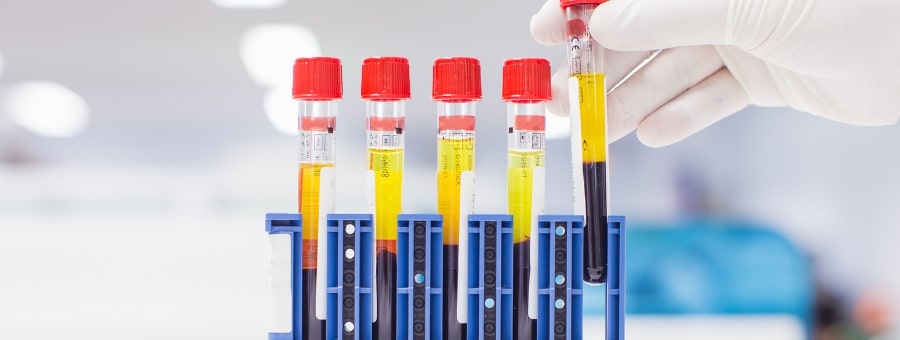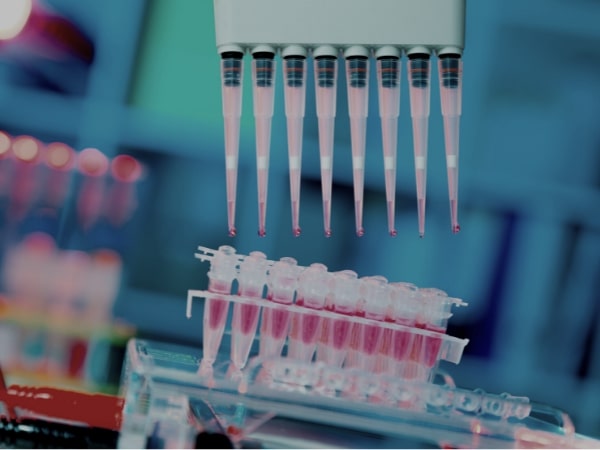Liquid biopsy: The future of minimal residual disease detection?
Written by Victoria Simms, March 16, 2022. reviewed by Celina Whalley, April 26 2024.

Detection of minimal residual disease
Minimal residual disease (MRD) is defined as a very small number of cancer cells that remain in the body during or after treatment.1 This may be locally at the site of surgery, distant at metastatic sites or at unknown micrometastatic deposits. The assessment of post-treatment minimal residual disease remains challenging clinically as current gold-standard methods do not exhibit sufficient sensitivity and specificity. Thus, both the patient and the clinician remain in a watch-and-wait scenario until the tumor once again becomes 'clinically manifest'. This wastes precious time where using a more sensitive and informative method such as liquid biopsy may allow the clinician to act earlier and stratify treatment more appropriately to enhance patient outcomes.
Liquid biopsy for detection of MRD
The concept of liquid biopsy was first postulated in 1977, when researchers observed higher concentrations of cell-free DNA (cfDNA) in the peripheral blood of cancer patients.2 Since then, biological fluids from patients, primarily plasma as well as urine, saliva, and cerebral spinal fluid, have been shown to contain tumor cell DNA which is released into the body (circulating) through cell death mechanisms.3 In 2022, cfDNA analysis was touted as a potential game changer for cancer, as it seeks to provide a real-time and comprehensive snapshot of tumur cell evolution, recurrence, treatment response, and even the presence of MRD.
Several key studies have further highlighted the transformative impact of liquid biopsy for MRD detection, illustrating the future clinical potential and real-world impact. A recent paper from Tie et al utilised an NGS 15-gene hotspot mutation panel on tumour tissue of stage III colon cancer patients.4 This was subsequently followed up by Safe-Seq (NGS with unique molecular identifiers) of plasma cfDNA with a single mutation per patient. CtDNA was detected in 20 of 96 (21%) postsurgical samples and was associated with inferior recurrence-free survival (hazard ratio [HR], 3.8; 95% CI, 2.4-21.0; P < .001).
Circulating tumor DNA was detected in 15 of 88 (17%) post-chemotherapy samples. The estimated 3-year RFS was 30% when ctDNA was observable post-chemotherapy and 77% when ctDNA was not observed (HR, 6.8; 95% CI, 11.0-157.0; P < .001). Postsurgical ctDNA status continued to be independently linked with RFS after adjusting for known clinicopathologic risk factors (HR, 7.5; 95% CI, 3.5-16.1; P < .001).
In 2019, Shaw et al. published a landmark study that illustrated that patient-specific ctDNA analysis is a high sensitivity and specificity tool for post-treatment disease surveillance: in this case, for breast cancer patients5. Currently, around 30% of cancer of breast cancer patients relapse post-treatment, yet there are no reliable and sensitive tests available clinically that monitor this or detect distant metastasis before tumour recurrence is 'clinically manifest'. However, this study illustrated the utility of ctDNA for MRD detection long before overt recurrence is detected. 49 patients with breast cancer were recruited post-surgery and adjuvant therapy. Plasma samples (n = 208) were collected every 6 months for 4 years. Personalised assays targeting 16 variants selected from primary tumor whole-exome data were tested in serial plasma for the presence of ctDNA by ultradeep sequencing (average >100,000X).
Plasma ctDNA was detected ahead of clinical or radiologic relapse in 16 of the 18 relapsed patients (sensitivity of 89%). None of the 31 non-relapsing patients were ctDNA-positive at any time point across 156 plasma samples (specificity of 100%).
These trials provide just two examples of how liquid biopsy can help to mitigate the post-treatment analysis issues associated with current standard clinical practice, allowing for real-time monitoring, trace detection and identification of patient subsets most at risk of relapse. In real world terms, this could result in enhanced, accurate and faster disease monitoring, more personalised treatment approaches and increased cost benefits for the clinic, as unnecessary therapies would not be administered.

Liquid biopsy: Considerations and solutions
However liquid biopsy is not without its challenges, requiring ultrasensitive and specific mutation detection methods, which can overcome extreme fragmentation (140-170bp) and low extraction yield (which can be expected to be 1-5ng cfDNA/ml of plasma in patients tested for MRD). Moreover, the ctDNA frequency in a background of cfDNA from normal cells can be likened to 'finding a needle in a haystack' with mutant allele frequencies as low as 0.01%. This is largely influenced by the tumor size, type, shedding rate and stage of the cancer.6
Blood collection and plasma separation methods are also critical for ensuring that ctDNA is not diluted further by the shedding of cellular DNA caused by white blood cell lysis , which in standard EDTA tubes will start happening within two hours of blood draw and would render a sample unviable after 24 hours. Therefore, blood should be collected in specialized tubes to preserve white blood cells from lyzing for longer, providing a more flexible workflow. Moreover, detection of ctDNA largely depends on the volume of plasma that the overall pool of cfDNA is extracted from. CfDNA concentrations are extremely low, therefore, the greater the volume, the higher the chance of finding tumor DNA, given the potentially extremely low frequency. It is therefore recommended that as much plasma is extracted as possible with a kit that is designed to specifically recover low concentration cfDNA.
Other considerations include the different methods of ctDNA analysis and in particular, achieving the sensitivity and depth of coverage necessary for liquid biopsy MRD detection, whilst keeping the costs and overall time expended to a minimum. NGS based methods offer the ability to sequence millions of DNA sequences in a single workflow and thus provide high sensitivity and a holistic approach that detects multiple ctDNA mutations at once for the maximum chance to discover MRD. In particular, targeted NGS panels offer automated and more concise workflows that simplify data analysis whilst maintaining high coverage and depth of reads.
Nonacus has developed the Cell3 Target range to enable sensitive and confident calling of mutations down to 0.1% VAF (when inputting 25 ng of cfDNA or more) and to ensure generation of high quality libraries for sequencing from inputs as low as 1 ng of DNA obtained from liquid or tissue biopsies. This enables the detection of relapse long before the cancer manifests clinically.
Liquid biopsy for MRD: concluding considerations
MRD detection through ctDNA analysis is one of the most promising and potentially transformative applications for liquid biopsy within oncology. These biomarkers provide a depth of holistic insight currently unseen within standard clinical practice and long before traditional relapse can be picked up via methods such as imaging. The research being undertaken at present also further bolsters this argument by showing the value of ctDNA as a clear indicator of MRD. Whilst there are still certain obstacles and standardization that needs to occur before its implementation into the daily clinic for MRD detection, these clinical trials show considerable promise and above all, a glimpse of the potential real-world impact that this non-invasive tool could have. As such, liquid biopsy may feasibly be the future of MRD detection.
References:
- NCI Dictionary of Cancer Terms, 2022. Definition of Minimal Residual Disease. Accessed April 26, 2024
- Cheng F, Su L, Qian C. Circulating tumor DNA: a promising biomarker in the liquid biopsy of cancer. Oncotarget. 2016;7(30):48832.
- Heidrich I, Ačkar L, Mossahebi Mohammadi P, Pantel K. Liquid biopsies: Potential and challenges. International Journal of Cancer. 2021;148(3):528-45.
- Tie J, Cohen JD, Wang Y, Christie M, Simons K, Lee M, et al. Circulating tumor DNA analyses as markers of recurrence risk and benefit of adjuvant therapy for stage III colon cancer. JAMA oncology. 2019;5(12):1710-7
- Coombes RC, Page K, Salari R, Hastings RK, Armstrong A, Ahmed S, et al. Personalized detection of circulating tumor DNA antedates breast cancer metastatic recurrence. Clinical Cancer Research. 2019;25(14):4255-63.
- Bettegowda C, Sausen M, Leary RJ, Kinde I, Wang Y, Agrawal N, et al. Detection of circulating tumor DNA in early-and late-stage human malignancies. Science translational medicine. 2014;6(224):224ra24-.
- Cheng F, Su L, Qian C. Circulating tumor DNA: a promising biomarker in the liquid biopsy of cancer. Oncotarget. 2016;7(30):48832.